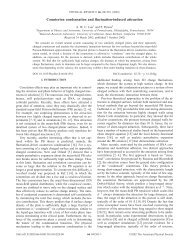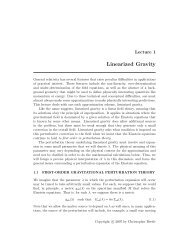Differential Geometry Exercises I: Tensors - Fau.edu
Differential Geometry Exercises I: Tensors - Fau.edu
Differential Geometry Exercises I: Tensors - Fau.edu
You also want an ePaper? Increase the reach of your titles
YUMPU automatically turns print PDFs into web optimized ePapers that Google loves.
5. [Schutz 3.5, p. 81]<br />
a. Show that if ¯V and ¯W are linear combinations (not necessarily with constant coefficients)<br />
of m vector fields that all commute with one another, then the Lie bracket of ¯V and ¯W<br />
is a linear combination of the same m fields.<br />
b. Prove the same result when the m vector fields have Lie brackets which are nonvanishing<br />
linear combinations of the m fields.<br />
6. Let ξ a be a Killing vector field for the metric g ab , and let η a be the tangent vector to a geodesic of<br />
g ab in an affine parameterization. Show that the inner product of these vectors is constant along<br />
the geodesic. What happens to this conserved quantity if one changes affine parameterizations?<br />
What happens if the parameterization is not affine?<br />
7. Let g ab be a stationary spacetime metric — meaning that it has a time-like Killing field t a —<br />
that solves the vacuum Einstein equations R ab = 0.<br />
a. Show that F ab := ∇ a t b satisfies the source-free Maxwell equations.<br />
b. Suppose that t a is in fact a static Killing field — meaning that it is orthogonal everywhere<br />
to some space-like surfaces Σ. Calculate the electric and magnetic parts of F ab<br />
on the static slices Σ.<br />
c. Use the Gauss law to compute the “electric charge” of the Schwarzschild metric<br />
ds 2 = (1 − 2M/r) dt 2 + (1 − 2M/r) −1 dr 2 + r 2 (dθ 2 + sin 2 θ dφ 2 ).<br />
Note that the static Killing field in this case is ∂ t , and that the static slices are the<br />
surfaces of constant t in spacetime.<br />
Hint: The electric charge is given by a flux integral. Show that one gets the same result<br />
no matter which two-sphere one uses in the integral. Then, calculate in the asymptotic<br />
region where r → ∞.






